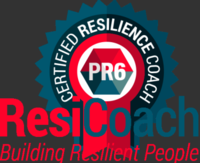Learn the Six Predictors of Resilience
What is resilience? It's an easy concept to grasp, someone who is resilient can meet any adversity and make their way through it. Simple enough. But, what if there is more than that. What if resilience runs deeper than a simple definition, what if it is more than just a mental construct?
To date that is all that resilience has been thought of as. However, ongoing research has provided greater clarity on the microbiological nature of how resilient someone is, and it has suggested that health factors affect mental well-being.
Research takes resiliency to a deeper level - a neurobiological model has been developed to prove a new resilience measurement scale. The scale maps out the causes of resilience, the lack of it and how it can be taught. Resilience is therefore not just a mental construct, but something science can find exactly in the brain, where it occurs and how we can affect it.
The PR6 model or Predictive 6-factor Resilience scale breaks down the traits of resilience and which parts of the brain that it stems from. This study breaks resilience down into 6 main groups. Vision, Composure, Tenacity, Reasoning, Collaboration and Health.
All of these factors measure how resilient a person is and why. The PR6 is a revolutionary approach to resilience as there is yet no "gold standard" of resilience that has been developed. Let's break down how this scale works.
1.Vision:
The first domain, vision, includes concepts of self-efficacy and the innate ability to achieve goals. Existing attempts at exploring vision as related to resilience include competence, sense of control and high standards. It is this sense of hopefulness, planning, and positive outlook that we incorporate in the vision domain.
Neurobiological structures involved in this domain include the ventral striatum through its role in higher order decision-making and risk/reward decisions. Memory storage and retrieval of information by the hippo campus and meaning assignment by the prefrontal cortex plays a part in maintaining a hopeful sense of the future, and this is reinforced by goal directness.
Think of vision as purpose. To be resilient towards adversity your brain needs a goal, a reason to persist.
2.Composure:
The second domain, Composure, is primarily about emotional regulation and the ability to recognise, understand, and act on internal prompts and physical signals.
Earlier models of composure itself include concepts of personal structure while the control aspect may also serve in the sense of self-control. These align well to the self-awareness emotional style, which relates neurologically to the ability of the insular cortex to effectively communicate with and enable regulation of the hypothalamicpituitaryadrenal axis (HPA). Self-awareness manifests through increased emotional granularity, where a positive disposition has been shown to improve physiological health.
In plain English the composure domain consists of self awareness, self-control and a positive attitude. The insular cortex or insula is shown to be responsible for this. Interestingly enough this part of the brain also seems to be linked to consciousness.
Being composed is integral in resilience. Just think of people you know in life, if they panic are you really composed? Those who are positive, display self-control and are self-aware and confidence, tend to be composed.
3.Tenacity:
The third domain, Tenacity, breaks down into two categories, perseverance and hardiness. We can see that the prefrontal cortex is a key part of the brain for this domain of the PR6. Based on many previous studies on the topic, most people in the field consider perseverance to be the primary characteristic of resilience.
Hardiness does play a role in responding to adversity, but there are areas of the brain other than the prefrontal cortex that play a role in tenacity. Interestingly enough, when it comes predictors of resilience perseverance found to be better than IQ. Considering that broader psychological resilience is inclusive of this ability to persevere, we termed this the Tenacity domain.
4.Reasoning:
Reasoning, the fourth domain, involves a wider range of higher cognitive traits such as problem-solving, resourcefulness, and growing through adversity. Study in this field has shown that novelty-seeking, self-relieance, acceptance of change and resourcefulness all as related to what we summed up as reasoning.
When you study the brain as it utilises reasoning, you can see that the left and right prefrontal cortex lobes. When these lobes are activated they work in conjunction with the anterior cingulate cortex or (ACC) to rapidly screen for errors in reasoning and then it comes up with the best responses to the situation.
Executive functioning here is enabled following the down regulation of the HPA axis through the Composure and Tenacity domains and functions in the broader context set by the Vision domain.
5.Collaboration:
Collaboration can be summed up as our sense of community or support networks.
This domain is common among resilience models. Family coherence, secure relationships and social resources are widely accepted as predictors of the collaboration domain.
As would be obvious, the collaboration domain is related closely to the next domain, health. Resilient individuals with strong social support have been shown to be better at coping with serious health issues such as cancer. This is strong evidence for collaboration as an integral domain of resilience.
6.Health:
Health can be broken down into three parts, regular exercise, nutrition and sleep.
The first, exercise, can be seen stimulating the hippocampal function and certain proteins. Exercise improves cognitive and memory functions, as well as ACC activation, which is key for the Reasoning domain.
The second, nutrition, is considered the psychological link between the broader influence of nutrition and well-being.
Lastly, sleep. Sleep, or rather lack of sleep; has been shown to degrade higher cognitive functioning along with increasing impulsiveness. In this way we can see that not maintaining proper sleep hygiene works against resilience.
How Do We Measure Our Teams Resilience?
The PR6 model measures momentum. Momentum gives us a forward-looking predictive model to help show the likely direction of development.
This model is used in clinical setting and for general coaching purposes. It helps to find problem areas so that you can strengthen those weakest links, to have the best possible change. The PR6 model is even used for sports teams and schools. It is applicable anywhere resilience is required and every team can always improve upon their resilience.
The results come complete with action plan suggestions to help being the strengthening. We are able to get results for individuals and for whole teams. It is useful on the professional and personal level for those reasons.
To learn more about resilence training click here or to book a FREE demo.



)
)
)
)
)
)
)
)
)
)

